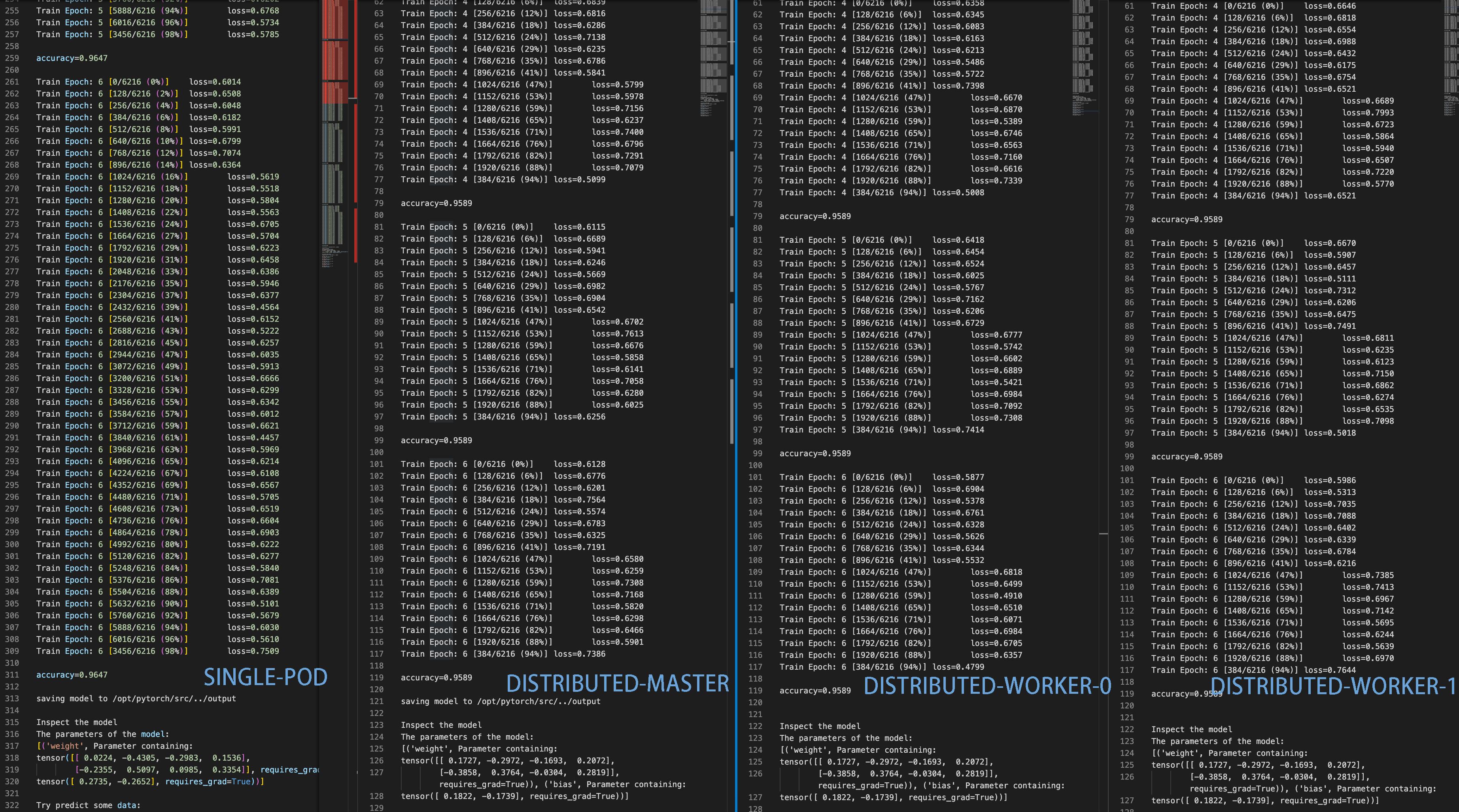PyTorch Distributed Training (PyTorchJob)¶
Introduction¶
PyTorchJob is a training operator in Kubeflow on vSphere. It allows you to run distributed PyTorch jobs on Kubernetes clusters. It provides a PyTorch-specific implementation of the Kubernetes Operator pattern, which automates the management of PyTorch training jobs.
With PyTorchJob, you define and manage PyTorch jobs as Kubernetes custom resources. The operator will then manage the creation, scaling, and deletion of the resources needed to run the job. This includes creating pods for PyTorch workers, launching PyTorch distributed training, and managing checkpoints.
PyTorchJob supports a range of PyTorch configurations, including single-node and multi-node distributed training, automatic and manual scaling, and more. Additionally, it supports a range of storage backends for storing training data, including local storage, NFS, and cloud storage solutions like Amazon S3 or Google Cloud Storage.
Overall, PyTorchJob simplifies the process of running distributed PyTorch jobs in Kubernetes, making it easier to manage training workloads at scale.
Get started¶
In this section, you create a training job by defining a PyTorchJob configuration file to train a model. Before that, you need a working Kubeflow on vSphere deployment with PyTorch Operator up and running. Also, you need to create a volume to save logs and model file for the training.
Verify PyTorchJob running¶
Check that the PyTorch custom resource is installed:
$ kubectl get crd
NAME CREATED AT
...
pytorchjobs.kubeflow.org 2023-01-31T06:02:59Z
...
Check that the Training operator is running via:
$ kubectl get pods -n kubeflow
NAME READY STATUS RESTARTS AGE
...
training-operator-0 2/2 Running 4 (6d1h ago) 6d2h
...
Create a new volume¶
In user’s namespace, create a new volume named data, with ReadWriteOnce access mode. The training job saves logs and model file in the volume.
export USER_NAMESPACE=user # replace it with your namespace
kubectl config set-context --current --namespace=$USER_NAMESPACE
export storageClassName=k8s-storage-policy # replace it with your environment storageclass
cat << EOF | kubectl apply -f -
apiVersion: v1
kind: PersistentVolumeClaim
metadata:
name: data
labels:
app: data
spec:
storageClassName: ${storageClassName}
accessModes:
- ReadWriteOnce
resources:
requests:
storage: 10Gi
EOF
Create a PyTorch training job¶
You can create a training job by defining a PyTorchJob configuration file. See the manifests for the distributed NLP example. You may change the configuration file based on your requirements.
You just choose one of the below YAML files to apply according to your environment. If you just have CPU environment, follow the YAML file to deploy the PyTorchJob resource with CPU to start training. If you have GPU environment, you follow the other YAML file to deploy the PyTorchJob resource with GPU to start training.
# Deploy the PyTorchJob resource with CPU
cat <<EOF | kubectl create -n $USER_NAMESPACE -f -
apiVersion: "kubeflow.org/v1"
kind: "PyTorchJob"
metadata:
name: "pytorchjob-distributed-training"
spec:
pytorchReplicaSpecs:
Master:
replicas: 1
restartPolicy: OnFailure
template:
metadata:
annotations:
sidecar.istio.io/inject: "false"
spec:
volumes:
- name: data
persistentVolumeClaim:
claimName: data
containers:
- volumeMounts:
- name: data
mountPath: "/opt/pytorch/output"
name: pytorch
image: projects.registry.vmware.com/models/kubeflow-docs/model-training-pytorch:1.11.0-cpu-py3.8-v0.1
imagePullPolicy: IfNotPresent
Worker:
replicas: 2
restartPolicy: OnFailure
template:
metadata:
annotations:
sidecar.istio.io/inject: "false"
spec:
containers:
- name: pytorch
image: projects.registry.vmware.com/models/kubeflow-docs/model-training-pytorch:1.11.0-cpu-py3.8-v0.1
imagePullPolicy: IfNotPresent
EOF
# Deploy the PyTorchJob resource with GPU
cat <<EOF | kubectl create -n $USER_NAMESPACE -f -
apiVersion: "kubeflow.org/v1"
kind: "PyTorchJob"
metadata:
name: "pytorchjob-distributed-training-gpu"
spec:
pytorchReplicaSpecs:
Master:
replicas: 1
restartPolicy: OnFailure
template:
metadata:
annotations:
sidecar.istio.io/inject: "false"
spec:
volumes:
- name: data
persistentVolumeClaim:
claimName: data
containers:
- volumeMounts:
- name: data
mountPath: "/opt/pytorch/output"
name: pytorch
image: projects.registry.vmware.com/models/kubeflow-docs/model-training-pytorch:1.11.0-gpu-cu11.6-py3.8-v0.1
args: ["--backend", "nccl"]
imagePullPolicy: IfNotPresent
resources:
limits:
nvidia.com/gpu: 1
Worker:
replicas: 1
restartPolicy: OnFailure
template:
metadata:
annotations:
sidecar.istio.io/inject: "false"
spec:
containers:
- name: pytorch
image: projects.registry.vmware.com/models/kubeflow-docs/model-training-pytorch:1.11.0-gpu-cu11.6-py3.8-v0.1
args: ["--backend", "nccl"]
imagePullPolicy: IfNotPresent
resources:
limits:
nvidia.com/gpu: 1
EOF
To verify the number of the created pods matches the specified number of replicas:
kubectl get pods -l job-name=pytorchjob-distributed-training -n $USER_NAMESPACE
Monitoring a PyTorchJob¶
Training takes 5-10 minutes to complete. Monitor the job status to become success and inspect logs to see the training progress:
kubectl get pods -n $USER_NAMESPACE | grep pytorchjob-distributed-training
kubectl logs -f pytorchjob-distributed-training-master-0 -n $USER_NAMESPACE
kubectl logs -f pytorchjob-distributed-training-worker-0 -n $USER_NAMESPACE
kubectl logs -f pytorchjob-distributed-training-worker-1 -n $USER_NAMESPACE
Test whether PyTorchJob is distributed training¶
Firstly, deploy the single pod to start training:
cat <<EOF | kubectl create -n $USER_NAMESPACE -f -
apiVersion: v1
kind: Pod
metadata:
annotations:
sidecar.istio.io/inject: "false"
name: "pytorch-training-single-pod"
spec:
volumes:
- name: data
persistentVolumeClaim:
claimName: data
containers:
- name: pytorch
image: harbor-repo.vmware.com/kubeflow_learning/lab3-pytorch-training:dlc-0.0.1
imagePullPolicy: IfNotPresent
volumeMounts:
- name: data
mountPath: "/opt/pytorch/output"
EOF
Waiting 10-15 minutes for the training process to complete and check logs.
Secondly, compare the training logs between the single pod and the PyTorchJob.

As shown in the picture, the model is trained 48 times for 6 epochs in the single-pod. And after using PyTorch operator, the model is trained 16 times individually in the master and 2 workers, although the loss value after each training is different, the accuracy obtained is the same after the master communicates with the 2 workers.